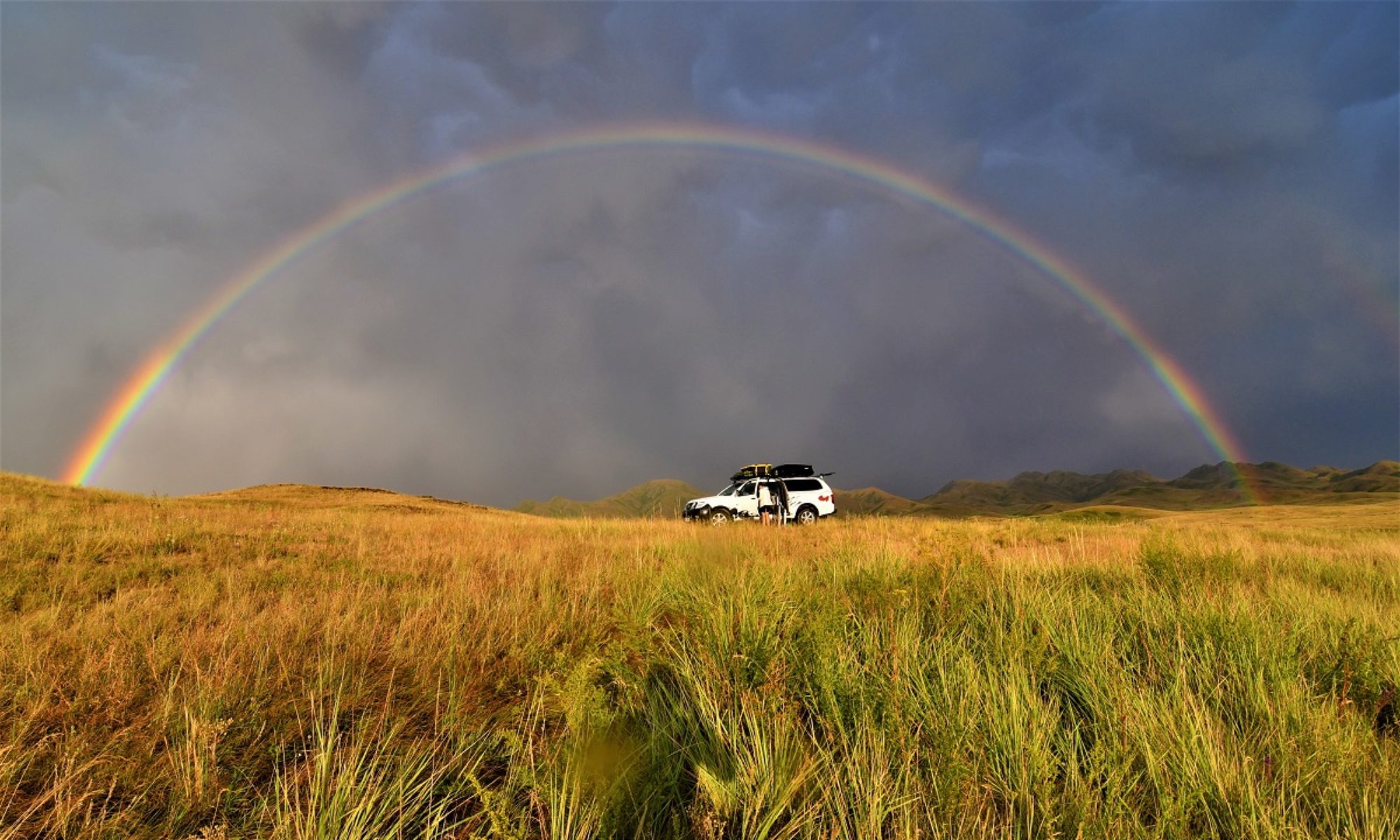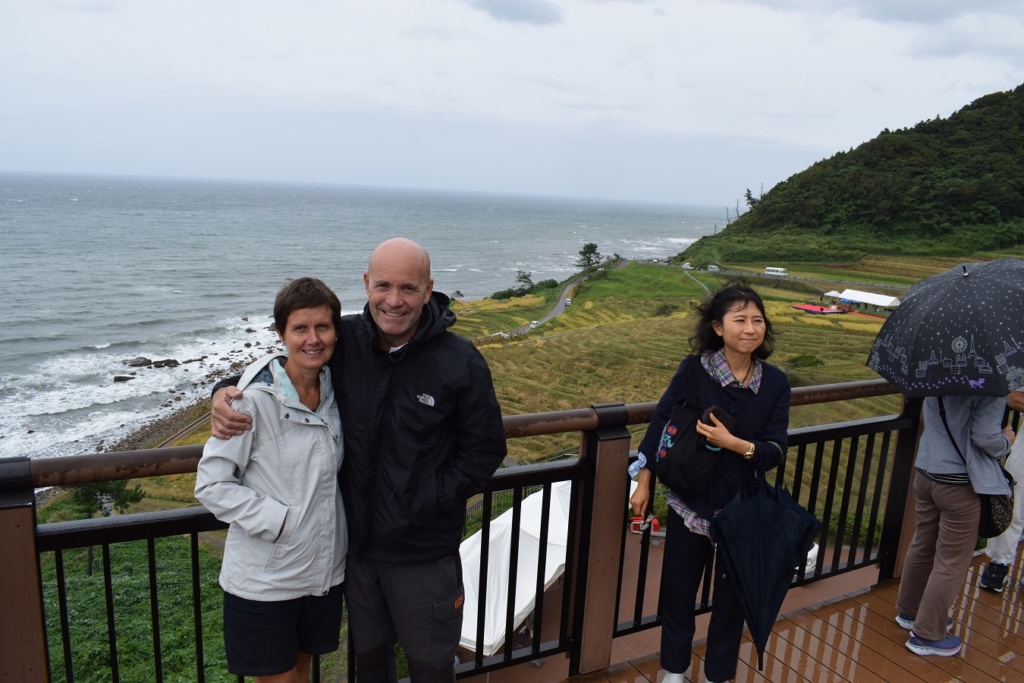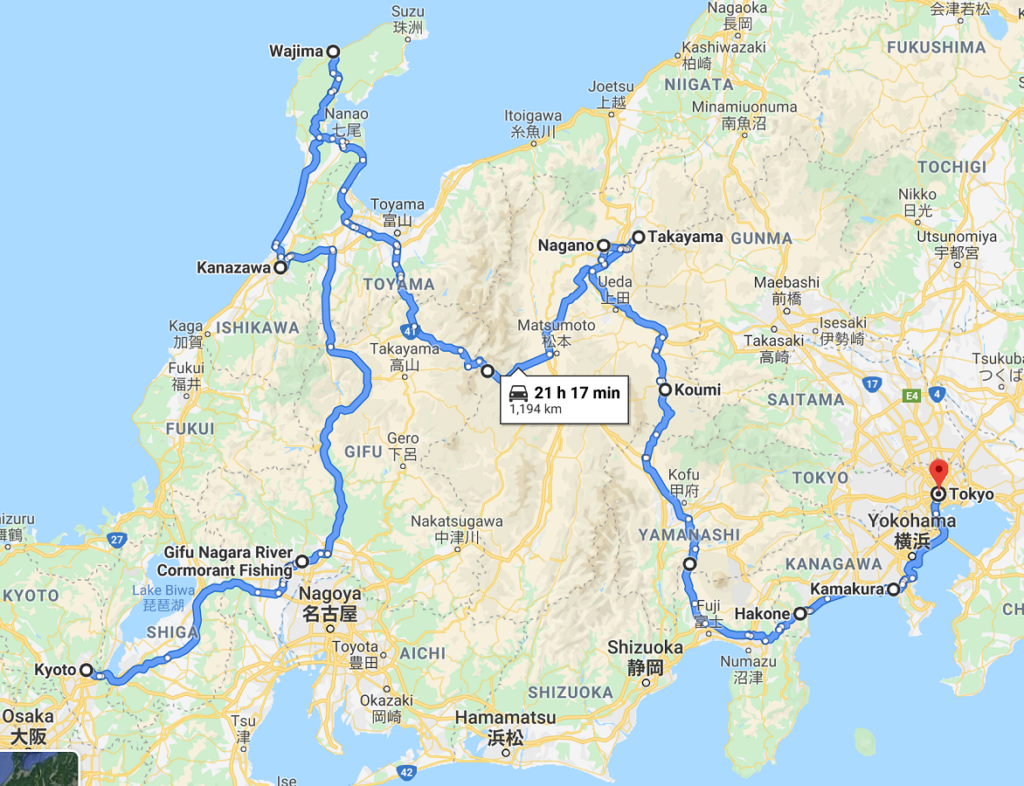
Monday 16th September, 2019 – KYOTO
Kyoto has many sites to visit but we headed first to the most famous one: KinkaKuji Temple, the Golden Temple.
Kinkakuji (金閣寺, Golden Pavilion) is a Zen temple whose top two floors are completely covered in gold leaf. Formally known as Rokuonji, the temple was the retirement villa of the shogun Ashikaga Yoshimitsu, and according to his will it became a Zen temple of the Rinzai sect after his death in 1408. Kinkakuji was the inspiration for the similarly named Ginkakuji (Silver Pavilion), built by Yoshimitsu’s grandson, Ashikaga Yoshimasa, on the other side of the city a few decades later.
Kinkakuji is an impressive structure built overlooking a large pond, and is the only building left of Yoshimitsu’s former retirement complex. It has burned down numerous times throughout its history including twice during the Onin War, a civil war that destroyed much of Kyoto; and once again more recently in 1950 when it was set on fire by a fanatic monk. The present structure was rebuilt in 1955. (You can wander through the park but you cannot go inside the Pavilion).
We then went down the road to the Ryoanji Temple.
Ryoanji Temple (龍安寺, Ryōanji) is the site of Japan’s most famous rock garden. Originally an aristocrat’s villa, the site was converted into a Zen temple in 1450 and belongs to the Myoshinji school of the Rinzai sect of Zen Buddhism.
The garden’s date of construction is unknown and there are a number of speculations regarding its designer. The garden consists of a rectangular plot of pebbles surrounded by low earthen walls, with 15 rocks laid out in small groups on patches of moss. An interesting feature of the garden’s design is that from any vantage point at least one of the rocks is always hidden from the viewer
Along with its origins, the meaning of the garden is unclear. Some believe that the garden represents the common theme of a tiger carrying cubs across a pond or of islands in a sea, while others claim that the garden represents an abstract concept like infinity.
Ryoanji’s garden is viewed from the Hojo, the head priest’s former residence. Besides the stone garden, the Hojo features some paintings on the sliding doors (fusuma) of its tatami rooms.
Tatami Mats: Even today, room sizes are quoted by the number of mats it can fit. to know more please go to https://mattressstuff.com/tatami-mat/
Tuesday 17th September, 2019 – Kyoto – Gion District
We visited Nijo Castle and went to the Imperial Palace but it was closed on that day for some holiday so we decided to go to the Gion district instead.
Gion is a traditional entertainment district lying north and south of Shijo Street, and stretching from the Kamogawa river in the west, as far as Yasaka-jinja Shrine in the east. Originally, this shrine was called Gion Shrine, and the entertainment area developed here to service its many pilgrims with food and drink.
Later, as kabuki drama became popular on the Gion district’s western edges, more sophisticated forms of entertainment were developed for the theater-goers, and so today Gion is known as Kyoto’s most famous geisha district. The streets and side alleys are lined with preserved machiya houses many of which now function as restaurants, serving Kyoto style kaiseki ryori (Japanese haute cuisine) and other types of local and international meals.
Interspersed among the restaurants are a number of ochaya (teahouses), the most exclusive and expensive of Kyoto’s dining establishments, where guests are entertained by geiko (Kyoto dialect for geisha) and maiko (geiko apprentices).
On the way we walked down Pontocho Alley, reputed to be the most beautiful street in Kyoto and had a rest along the bank of the river Kamo-Gawa. You see a lot of people wearing the traditional yukata (cotton kimono for men and women) which are available for rental in many places.
Wednesday 18th September, 2019 – Kyoto- Fushimi district
Today we headed to the Fushimi district which is a traditional sake brewing district along the willow-lined Horikawa River in southern Kyoto. Revered for the clean, soft water that flows in abundance from the river’s underground springs, the district is home to nearly 40 sake breweries. Fushimi has been one of the leading sake brewing districts in the country.
Among the local breweries is industry giant Gekkeikan which was founded here in 1637. We visited their museum explaining the sake brewing process with many exhibits, did some sake tasting and then walked in the local streets where many of the district’s buildings have preserved their traditional appearance with wood and white-plaster walls. Sake breweries are recognizable by the cedar ball “sugidama” hanging from the roof.
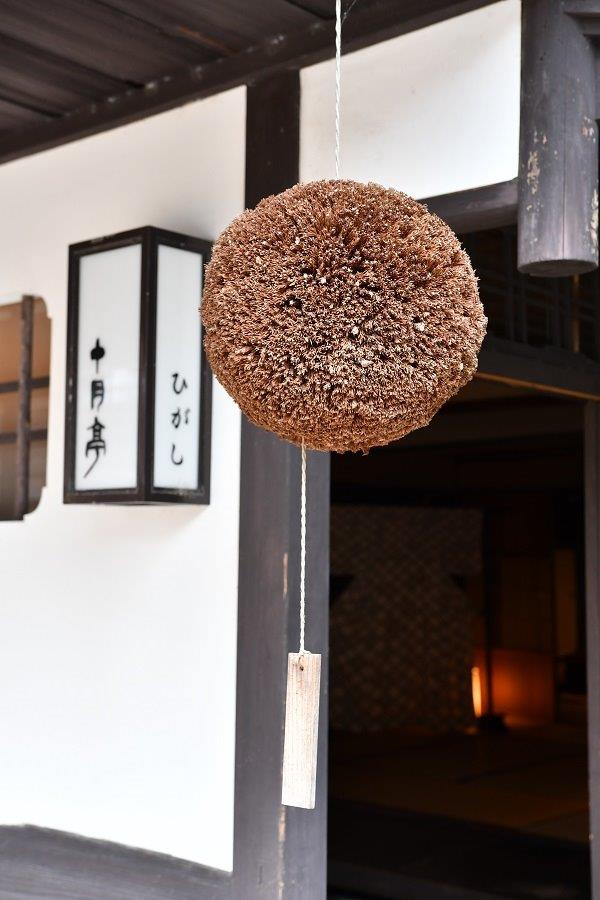
Fushimi Inari Shrine
The shrine is nice enough but the real attraction is the thousands of vermilionTorii gates which form a path starting behind the shrine and going all the way to the top of sacred Mount Inari ( 233m high).
Inari is the Shinto god of rice. Foxes are thought to be Inari’s messengers, resulting in many fox statues across the shrine grounds. They often hold some symbolic object in their mouth such as a key to the granary.
At the very back of the shrine’s main grounds is the entrance to the torii gate-covered hiking trail, which starts with two dense, parallel rows of gates called Senbon Torii (“thousands of torii gates”). The torii gates along the entire trail ( 4km long) are donations by individuals and companies to bring them good luck, and you will find the donator’s name and the date of the donation inscribed on the back of each gate. The cost starts around 4,000 USD for a small sized gate and increases to over 10,000 USD for a large gate. More are added all the time….
Thursday 19th September, 2019 – GIFU
Gifu Prefecture is a landlocked region but it is famous for its cormorant fishing on rivers. We arrived in Gifu town just in time to take a tour on special wooden long boats from which you can see traditional cormorant fishing .(a demonstration show put on for tourists…) on the Nagara river.
There is a small museum where you can watch a video explaining the whole process before you go onboard and it is just as well, as what you see on the boat is limited. The fishing is done at night and the only light is coming from a brasier on each fishing boat. You can barely see the birds in the water.
Ukai -cormorant fishing – has a history of around 1,300 years. Ukai is a traditional night fishing method in which an usho (Cormorant Fishing Master) and u (cormorant birds) work together to fish by the flames of Kagari-bi (fishing fire lanterns).
There are six usho Cormorant Fishing Masters working the Nagara River, and their skills have been carried on by hereditary succession within their families. The cormorants are trained to nab the fish, A snare around the bird’s neck stops it from eating the catch, although it is allowed to keep every eighth fish as a reward. The Usho wears a skirt made of straw for its water repellent properties and stands at the bow of the boat holding the strings of up to 8 birds at a time. The birds are carried onto the boat in a special basket.
Friday 20th September, 2019 – Kanazawa
The road we wanted to follow was closed and sometimes this things happen for the best. We ended up on small roads with great scenery and nice houses.
Kanazawa has many historical attractions but the one we really wanted to see was Kenrokuen (兼六園) , classified as one of Japan’s “three most beautiful landscape gardens”.The spacious grounds used to be the outer garden of Kanazawa Castle and were constructed by the ruling Maeda family over a period of nearly two centuries. Opened to the public in 1871, Kenrokuen features a variety of flowering trees which provide the garden with a different look for each season.
We arrived late afternoon and may be we did not see the garden at its best but we were disappointed ( we preferred “Yushien” the garden we visited on the first day in Japan which, though small, seemed to have all the relevant qualities).
There were a couple of nice areas, some of the trees were supported by poles due to their size/ age .
Saturday 21st September, 2019 – Kanazawa
We went to the old “pleasure quarter” where Geisha entertained their customers. A couple of former houses have been kept as museums and are open to the public. We wandered through the old streets.
Sunday 22nd September, 2019 – WAJIMA
The town is known in Japan for its lacquerware, called Wajima-Nuri in japanese.
There are artifacts showing lacquer was used to decorate and strengthen a shrine door from the 14th century. Wajima-nuri uses a technique that is unique to the area, mixing a finely powdered mineral, jinoko, with the lacquer in the early stages of production for extra durability. The rougher, earlier layers are then coated with more layers of finer lacquer, which is polished to a lustrous shine, and often decorated with designs made of gold and other precious materials.
Lacquerware is used in everyday items such as bowls, chopsticks, tea ceremony trays, decorative and ceremonial objects etc.. but in view of the cost it is more likely to be used in special occasions only !
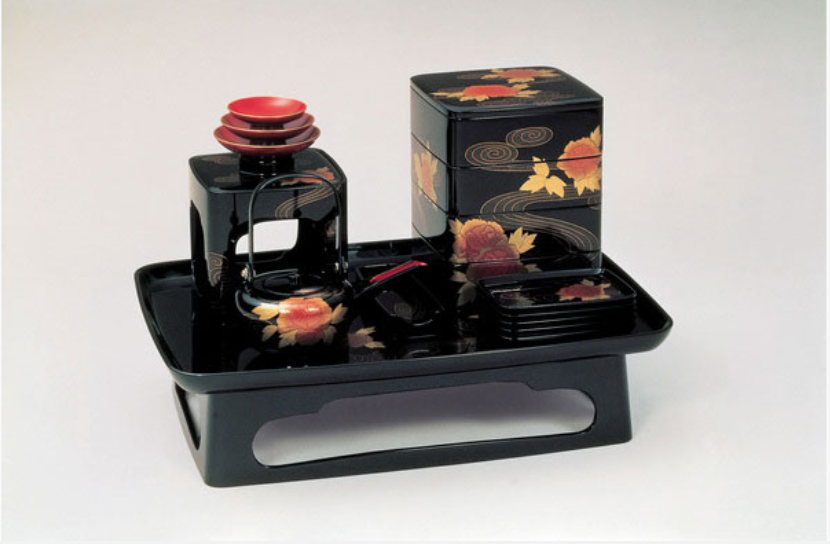
We strolled through the daily morning market where fresh seafood, lacquerware, and other handicrafts are on offer. There are also numerous shops selling the famous lacquerware and an interesting museum at the Lacquerware Center.
Up the coast, not far from the town, there is a small Senmaida ( paddy fields) but the weather was not with us( another typhoon on the way) and it is rather small. There are actually 1004 fields which are either owned and tended to by families, or rented out and looked after by the locals. Each year in the last week of September two couples are drawn from a nationwide lottery to have their wedding ceremony at Senmaida. The event is open to the public.
Monday 23rd September, 2019 -Nanto – Shirakawa-go and Gokayama
At the Michinoeki ( rest stop) where we camped last night we found out there was a festival happening at Nanto today. It is normally held in the temple grounds but has been moved to the local gymnasium because of the typhoon. the Mugiya Matsuri Festival is held every year over a couple of days.
Preparations were still going on when we arrived but soon we were invited to take part in a lesson and learn the traditional “hat dance”. Two dancers did a short demonstration and then a teacher put us through our paces. Not that easy!
We then let the professional show how it is done and we watched a few dances accompanied by live traditional music.
We then took the road to Shirakawa-Go and Gokayama, two Unesco World Heritage villages with typical thatched A-frame buildings, built in a style of rustic architecture known as gassho-zukuri (“praying hands”).
Tuesday 24th September, 2019 – TAKAYAMA
Takayama is known as a “little Kyoto” for its gridiron street plan and preserved, historic, wooden buildings. The city is also famous for its traditional crafts, fine sake and spring and autumn Matsuri festivals.
Takayama Matsuri is one of Japan’s most famous festivals, when ornately decorated floats (known as yatai) are paraded through the city streets in a procession of people in Edo Period costume accompanied by sacred flute and percussion music. We were too early to see the autumn Matsuri, held in October, but 4 of the 11 floats used in the parade are on display on a rotation basis, at the Takayama Matsuri Yatai Kaikan (museum). The floats are known for their detailed and colorful carvings, lacquer- and metalwork and amazing marionettes (karakuri).
